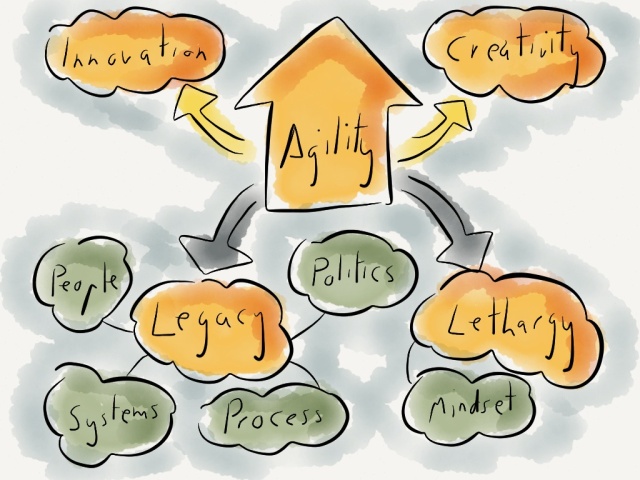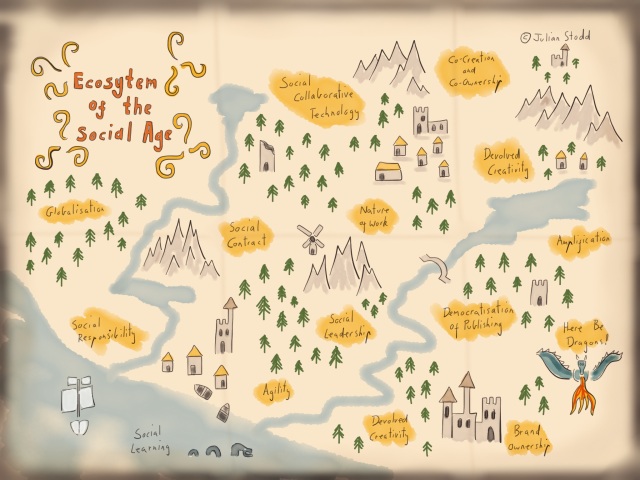In London for the day yesterday: i asked the taxi driver how busy he’d been. Not busy at all, was the answer: it’s Uber, he said, they’re stealing the market. Tough times, he said. There was talk of reducing the rates the black cabs charge. They were developing their own App too. But too little too late?
Back in Amsterdam, my brother is visiting with the family. They’re staying in an AirBnB apartment. All four of them, less than half the price of a hotel, more convenient, more space. And you don’t just get the room: this AirBnB collective have produced an Amsterdam magazine, with discount vouchers and a guide of things to do.
I’m looking for an artist to work up some of my maps to print quality. I’m connecting through WhatsApp to some groups of creatives, as well as through LinkedIn. No recruitment agency, no advert in the papers. Just connections into my network and a request for recommendations.
Uber stole the market because it’s convenient, often cheaper and adopted technology at it’s heart. AirBnB now has more rooms globally than all the hotels combined. Why? Because it disrupted the model: hotels thought we wanted more pillows on the bed, a spa and to pay extra for breakfast. But we didn’t. We loved the quirky spaces and personal engagement we get by staying in someone’s house. And they adopted technology fast, they are built upon it.
Both have scaled through community, not advertising. And community is how i’ll source my maps, indeed, the power of community is what powers my business. People connected around the world: sense making, sharing, problem solving, creating.
There’s a library in New York that’s cleared a whole gallery out to instal 3D printers. A creative space: where libraries used to connect us with knowledge (back in the age where to concentrated knowledge in institutions and books), they now start to connect us with capability too. Because 3D printing isn’t just about creating artefacts: it’s about rapid prototyping and agility.
The Social Age is about change: not as aberration, but the norm. Changes not only in infrastructure and organisation, but in sociology and habits too. The old institutions of ‘career‘ and ‘work‘, even ‘formal learning‘ are eroding, replaced instead by empowering technologies, democratised spaces and creative ways of achieving ever moving goals. Agility in technology, agility in mindset, agility through community.
And nobody is immune: organisations that view change as something they can plan for and adapt to are missing the point. It’s not a one time change, it’s a running river. It requires agility to navigate: the ability to diagnose, to solve, within community, to do it again tomorrow, but differently.
Organisations need different ways of engaging with people, different approaches to learning, more co-created and co-owned, different models of change, different approaches to brand and marketing, creative business models, and adaptability in everything they do.
Yesterday i mentioned ‘asymmetric competition‘, in a rather offhand way, but that is the reality of the Social Age. AirBnB was not always big, but it was always a good idea. And it was the momentum and amplification of community that made it big. I started using it because a friend recommended it, and my brother uses it because i do. On my first AirBnB stay, with Toby and Jo (both near their 80’s) in San Francisco, they put me on to Uber, so i started to use that too.
Asymmetric competition is that which comes from the side, from below. Small entities able to topple giant corporations, not in a hundred years, but in five. Borne on a wave of community. Because they deliver true value.
The catalyst for this change is disruption: the newcomers don’t have to assail the walls that organisations have surrounded themselves with, because they compete on asymmetric terms. The banks built branches and call centres and thought themselves secure behind the ramparts, but then PayPal subverted that by offering convenience, on my terms. The defences of yesterday will not repel the attacks we face today.
I see this in every space, from financial services to government, military to education, retail to transport. Look at how car sharing services and short term, curb-side rentals are becoming common. Because do you really want to own a car, or do you want the convenience of driving one within five minutes of desire? At a fraction of the cost.
I find it strange that i get a lot of interest from the military around some of these ideas, but that’s my preconception at play. Because even these most hierarchical of entities recognise the importance of agility, problem solving and taking definitive action. And they recognise that both the threats they face and the people they work with have changed.
As i sit today, in a shared workspace, with cafe, power and free wifi, surrounded by the artisan workers of the Social Age, nothing has ever been clearer: it’s a democratisation of power and the ownership of the brand of me, by me. Organisations that want to attract and retain the best talent need to recognise this.
Earlier i sat with a friend completing some corporate training as part of their induction. It was dire. Dreadful. It started with some clip art of serious looking and culturally diverse individuals pointing at a computer screen and went on to spend half an hour telling me how to take notes in a meeting. All the time using a monotonous and soporific audio track, stock imagery and text that was too small and spread across the screen. But, worst of all, it patronised me. My response was not passive boredom, but active dislike. It literally went out of it’s way to pull my levers and annoy me. It’s stance, tone of voice and delivery were abstract and distanced from my everyday reality and it lacked any authenticity.

We need to be agile, but agility is dragged down by legacy and lethargy. People, processes, technology and politics can all play a part in this. It’s about mindset.
This is the problem that organisations face: they continue to do what they’ve always done, with maybe a vague awareness that change is on the horizon. But it’s not. It’s here right now and it’s tunnelling under the walls. The price of lethargy is redundancy and failure. Now is the time to change: adopt agile practices and agile mindsets, embrace Social Leadership to link you into sense making communities, be fair, be proactive, adapt and share your story as you learn. And start now.





Oh man, had to laugh at that corporate induction bit. So true! That stuff is so terribly patronizing. After school/uni I gave the corporate world a really good go and did excellently by their standards… but the rigidity was stifling so I managed to get myself out after just 3 years. My concern with the structures we’ve inherited is that they seem to dis-empower people on mass, except for those who are comfortable with fluidity. I know so many people, like your taxi driver, who say kind of helplessly, “tough times” without realizing all the options and possibilities that are open to each person, now, to take.
Pingback: Disruption: Catalyst of the Social Age | Busine...
Reblogged this on juandon. Innovación y conocimiento.
Pingback: Disruption: Catalyst of the Social Age | Rustic...
Pingback: This Week’s Links « Timothy Siburg
Pingback: Uncommonly Global | Julian Stodd's Learning Blog
Pingback: Reflections from CIPD Show 2015 Day 1 | Julian Stodd's Learning Blog
Pingback: Groundswell: waves of change | Julian Stodd's Learning Blog
Pingback: 1,000 | Julian Stodd's Learning Blog
Pingback: Midnight Cowboy | Julian Stodd's Learning Blog
Pingback: The Illusion of Real Life | Julian Stodd's Learning Blog
Pingback: Brooklyn: Rough Trade and Culture | Julian Stodd's Learning Blog
Pingback: 3 Organisational Change Curves: Dynamic, Constrained, Resisted | Julian Stodd's Learning Blog
Pingback: #WorkingOutLoud – Black Swans and the Limits of Hierarchy | Julian Stodd's Learning Blog
Pingback: Traditional Strengths | Julian Stodd's Learning Blog